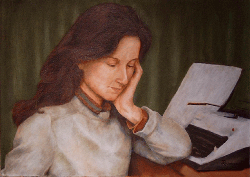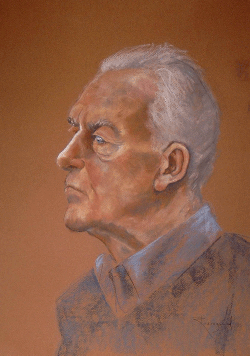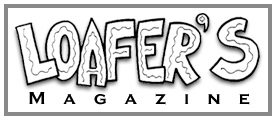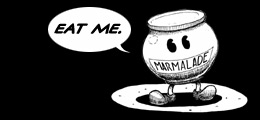Painting A Portrait
Pamela Rosengard
 In a day and age when the quality of photography seems to almost yearly exceed what we had hitherto been able to conceive, it is understandable to ask what place a painted portrait has in the contemporary world. If it is possible to not only produce photos with a remarkable clairty of depiction and color, but also to manipulate for a near endless number of special effects, what is the point of painting a portrait? It is certainly no longer necessary to paint a portrait in order to record a likeness of someone. That can be done much more quickly and economically with a camera. We cannot argue with the fact that the advent of photography was a major contributor - along side massive sociocultural and political upheaval - to the dramatic shift away from realistic representation (or even representation at all) in modern art. In a day and age when the quality of photography seems to almost yearly exceed what we had hitherto been able to conceive, it is understandable to ask what place a painted portrait has in the contemporary world. If it is possible to not only produce photos with a remarkable clairty of depiction and color, but also to manipulate for a near endless number of special effects, what is the point of painting a portrait? It is certainly no longer necessary to paint a portrait in order to record a likeness of someone. That can be done much more quickly and economically with a camera. We cannot argue with the fact that the advent of photography was a major contributor - along side massive sociocultural and political upheaval - to the dramatic shift away from realistic representation (or even representation at all) in modern art.
In most contemporary homes, the well-framed photograph has taken the pride of place that the painted portrait once held. Additionally, well rendered, and less well rendered, reproductions of artworks, i.e. "prints", have become widely available and economical. Thus photographs and reproductions are much more likely to be seen in the average home than is original artwork. Furthermore, though I have no way of proving it, I think that portraiture may even be the least likely form of orginal artwork to be found in the contemporary home.
So what am I doing setting about to paint near exclusively portraits - and not only that, but in a realistic direction, employing basic old master techniques and some borrowings from impressionism?
The reason is simple: I passionately love portraits. I love to paint them and I love to view them. I love the richness of the mediums - be it oil, acrylic, pastel, or tempera, or mixed media. When I have the privilige of visiting a wonderful art museum, no matter the excellence of the landscapes, the still lifes, the abstract or expresssionistic art, it is the portraits which rivet my attention. I return again and again to them. They follow me. It was a small portrait of no more than 10 inches done by Anders Zorn, which set my heart racing and my hands shaking as I stood before it in the Zorn Museum in Mora, Sweden. And it was a temporary exhibit in the Jewish Museum in Berlin, Germany of self-portraits done primarily by Jewish painters in the late 1920s, which reduced me to great wracking sobs. Despite all the other exhibits which drove home over and over the rich, vibrancy of life and the horror of the Shoah, it was the portraits - and the accompanying labels presenting the record of their deaths - which filled me with the most acute experience of loss.
It is the emotional intimacy of a portrait which pulls me. This can be be beautiful, but it can also be terrifying. In fact, I believe that a painted portrait, which is life-like to at least some degree, can potentially be more disturbing, risky or even radical than completely non-representational art. This is so because the viewer is confronted by someone looking at him or her. Even in portraits where the subject is not looking out at the viewer, there is an intimacy because the viewer is allowed to very directly look at that person on the canvas. Such intimacy can be very threatening. A portrait compells you. You cannot easily ignore it. A portrait, well-done, is always a confrontation with a human being. You begin to wonder, to think, to ask questions. You are given a small window into this person's life.
Far from seeing photography as an enemy and rival of the painted portrait, I see it as an art form in and of itself, and also as a powerful tool in painting. We tend to have a romantic notion that the old masters would never have used photographs as subjects or in preparing their paintings. If one digs into early writings from artists, however, one will be disabused of this notion. The fact is, that in the history of realistic portraiture, painters by and large embraced new technological tools such as grids, shadow boxes, camera obscuras, mirrors reflecting into mirrors, etc. as aids in getting a basic outline unto the canvas, so that they could then set about doing the real work of painting: creating the magic of color, form, stroke, shadow, light and darkness on a flat plane.
I very much like sketching portraits directly from a model as my subject. I would simply adore the chance to have a person sit for me for the weeks, or months that it would take to finish a painting done in one of the old-master-techniques. (To explain such methods very briefly: a color layer is applied and allowed to dry before yet another layer is applied, again and again until finally the painting is finished.) This allows for a very particular richness, depth and three dimensionality. But it also requires a subject with a great deal of time, patience and the ability to sit still. I haven't yet found anyone willing to commit to such long-term posing. Even when painting a portrait in a quicker style, say with pastels or wet-in-wet painting (such as used in impressionism), it is usually still necessary to spend several hours for a realistic portrait. It is possible to do such work in art workshops, but few people who might requisition an artist to paint a portrait would be willing to sit these several hours. The contemporary subject, in fact, tends to want and expect the artist to work from a set of photos. Bowing to this, my ideal would be to do a set of firsthand live sketches and to shoot numerous photos to use as my resource materials for painting a portait in an old-master-technique.
 There are other advantages to using photographs as base materials. It is possible, for example, to use a photo or set of photos to create a basis for a retrospective painting of the subject - that is a painting of the subject at an earlier age. This was the case in the painting The Dissertation (right) included here. Digging through a box of photos, looking for a subject which I could paint indoors during the dreary German winter, I found a snapshot of myself at a much younger age working on my dissertation. This photo was taken without me being aware of it. This capturing of a moment is another advantage of working with photos. I very much liked the basic composition, but was able to take the liberty of strongly changing the color scheme and eliminating unnecessary details. This painting illustrates the combination of realistic old master techniques combined with some more modern styles. The typewriter, for example, is necessary to include in the story of this painting, but it is deliberately painted roughly, with almost no detail, thus allowing the more realistically depicted figure to remain central. There are other advantages to using photographs as base materials. It is possible, for example, to use a photo or set of photos to create a basis for a retrospective painting of the subject - that is a painting of the subject at an earlier age. This was the case in the painting The Dissertation (right) included here. Digging through a box of photos, looking for a subject which I could paint indoors during the dreary German winter, I found a snapshot of myself at a much younger age working on my dissertation. This photo was taken without me being aware of it. This capturing of a moment is another advantage of working with photos. I very much liked the basic composition, but was able to take the liberty of strongly changing the color scheme and eliminating unnecessary details. This painting illustrates the combination of realistic old master techniques combined with some more modern styles. The typewriter, for example, is necessary to include in the story of this painting, but it is deliberately painted roughly, with almost no detail, thus allowing the more realistically depicted figure to remain central.
In the The Boy with the Flannel Shirt (above), I used a photo I shot of my nephew as a basis because it captured a theme very particularly. I was free, however, to change elements which were unnecessary or disruptive. By the way, getting this highly active young boy to sit still as a subject for even three minutes would have been an exercise in futility.
 With A Study of an Older Man (left), I had the opportunity to do a pastel painting directly from the subject because the gentleman posed for a weekend-workshop. This is a typical academic study. It offers an example of a quicker, more "sketched", yet modeled, style. This painting took approximately four and half hours. There are painters who could no doubt do this much more quickly. With A Study of an Older Man (left), I had the opportunity to do a pastel painting directly from the subject because the gentleman posed for a weekend-workshop. This is a typical academic study. It offers an example of a quicker, more "sketched", yet modeled, style. This painting took approximately four and half hours. There are painters who could no doubt do this much more quickly.
When I am painting a portrait, the color and the stroke of the brush or of the pastel is all that exists. I am utterly in the present moment. I do not resent doing a painting slowly, layer by layer. In fact, I find it liberating. It is a liberation from the pressure to do everything in a hurry. When I am working faster, such as when doing a pastel, which I will attempt to finish in one day, the focus is much more intense, but time is nevertheless suspended. By the end of the day, however, I am exhausted. If I think that the portrait says something however, I go to bed content. My wish is probably the same that it has been for countless portrait painters, namely, to paint a portrait that is not only of interest to the family and friends of the subject, but to complete strangers. For me, painting a portrait is an act of great respect and honesty, and at times even an act of love. It is a meditation.

 Loafer's #2A, One Shot Loafer's #2A, One Shot
Four page 'issue' included in shameless letter begging for money. Letters by Henry W. Yellowbutter-on-the-fields, Carlo De Fumeur, Eric Clason, Alexander Pumpkin, Samuel A. Ferndecker, George Herbert Walker Feathersmith, Larry Barkoff, Betty Clason (Mom), and Billy Bob Billybobham; poems by Andrew Clason and Ignot Allpepper; a story by Richard Wilson. Crayon drawn cover of the front foyer of the Loaf Shack on Albert Street, East Lansing, Michigan (now a parking lot), by Peter Schilling Jr.
|



